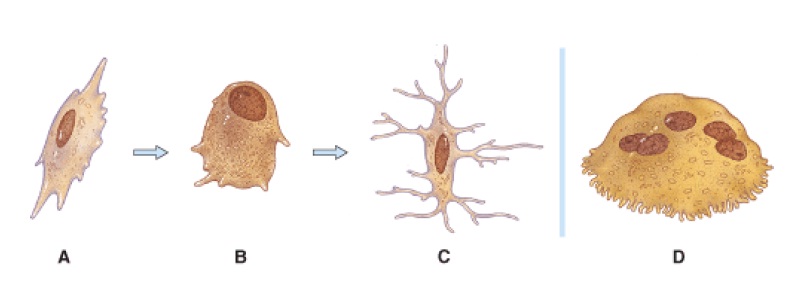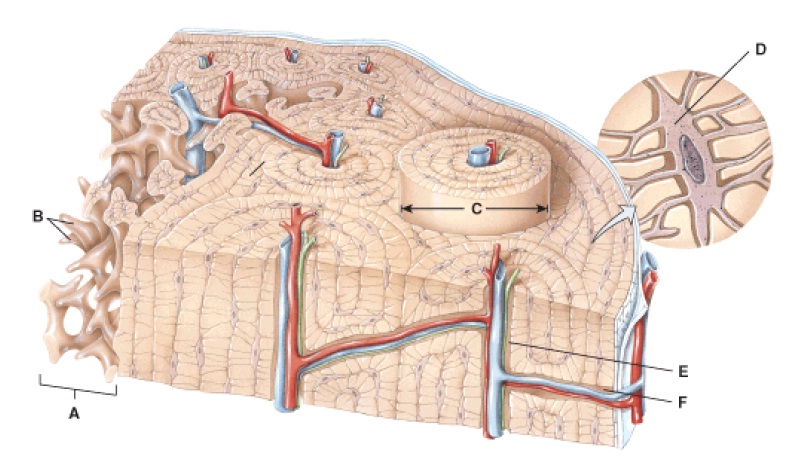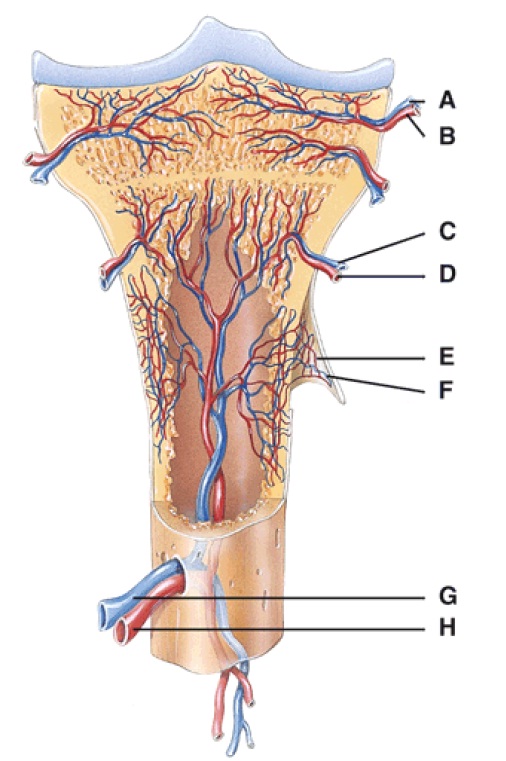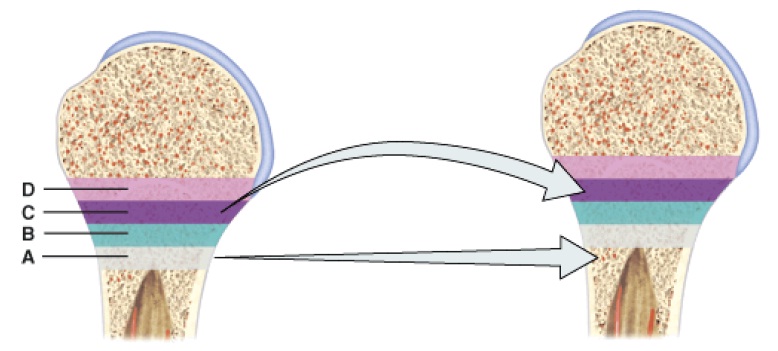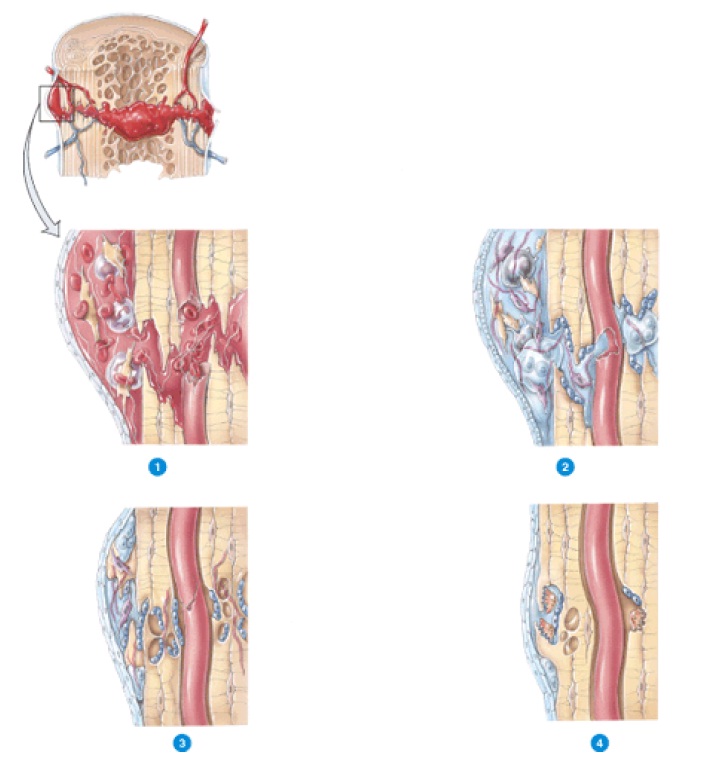Quiz About Bones In Cellular Level

Everything about bones in cellular level. Linked to the 'Childhood' case unit.
- 1.
This is a structure of a long bone that stores energy.
- A.
Diaphysis
- B.
Epiphysis
- C.
Metaphysis
- D.
Periosteum
- E.
Marrow
Correct Answer
E. MarrowExplanation
Marrow is the correct answer because it is the soft tissue found inside the diaphysis and epiphysis of long bones. Marrow is responsible for producing red and white blood cells, as well as storing fat and minerals. It is considered to be an energy storage site within the long bone structure.Rate this question:
-
- 2.
This is the region of a long bone that articulates with other bones.
- A.
Diaphysis
- B.
Epiphysis
- C.
Metaphysis
- D.
Periosteum
- E.
Marrow
Correct Answer
B. EpiphysisExplanation
The epiphysis is the correct answer because it is the region of a long bone that articulates with other bones. It is the rounded end of the bone that forms a joint with another bone, allowing for movement and flexibility. The epiphysis is covered in a layer of smooth, slippery cartilage called articular cartilage, which helps to reduce friction and cushion the joint during movement.Rate this question:
-
- 3.
This is the shaft of a logn bone.
- A.
Diaphysis
- B.
Epiphysis
- C.
Metaphysis
- D.
Periosteum
- E.
Marrow
Correct Answer
A. DiaphysisExplanation
The correct answer is Diaphysis. The diaphysis refers to the main shaft or the middle part of a long bone. It is the longest and most cylindrical part of the bone, typically containing compact bone tissue. The diaphysis is responsible for providing support and strength to the bone, as well as housing the bone marrow. It is also the area where bone growth occurs during childhood and adolescence. The other options, epiphysis, metaphysis, periosteum, and marrow, are not the correct answer as they refer to different parts or structures associated with bones.Rate this question:
-
- 4.
This is a lyaer of hyaline cartilage that reduces friction between bones involved in the joint.
- A.
Periosteum
- B.
Distal epiphysis
- C.
Nutrient foramen
- D.
Articular cartilage
- E.
Epiphyseal plate
Correct Answer
D. Articular cartilageExplanation
Articular cartilage is a layer of hyaline cartilage that covers the ends of bones in a joint. Its main function is to reduce friction between the bones, allowing them to glide smoothly against each other during movement. This cartilage also helps to absorb shock and distribute the load evenly across the joint. It is essential for maintaining joint health and preventing damage to the bones.Rate this question:
-
- 5.
This is a layer of hyaline cartilage that allows the diaphysis to grow in length.
- A.
Periosteum
- B.
Distal epiphysis
- C.
Nutrient foramen
- D.
Articular cartilage
- E.
Epiphyseal plate
Correct Answer
E. Epiphyseal plateExplanation
The epiphyseal plate is a layer of hyaline cartilage that allows the diaphysis (long shaft) of a bone to grow in length. It is located at the ends of long bones, between the epiphysis (ends) and diaphysis. During growth, new bone is formed on the diaphyseal side of the plate while cartilage is replaced by bone on the epiphyseal side. This process allows for the lengthening of the bone until the growth plate eventually closes and is replaced by solid bone.Rate this question:
-
- 6.
This is the region in mature bone where the diaphysis and the epiphysis join.
- A.
Epiphyseal plate
- B.
Epiphyseal line
- C.
Metaphysis
- D.
Diaphyseal line
- E.
Diaphyseal plate
Correct Answer
C. MetaphysisExplanation
The metaphysis is the region in mature bone where the diaphysis (the shaft of the bone) and the epiphysis (the end of the bone) join. It is the area of active growth and development in growing bones. The metaphysis contains the epiphyseal plate, a layer of cartilage that allows for longitudinal bone growth, and eventually becomes the epiphyseal line in adults. Therefore, the metaphysis is the correct answer for this question.Rate this question:
-
- 7.
This is a lining found in bone that promotes bone growth in width.
- A.
Periosteum
- B.
Endosteum
- C.
Marrow
- D.
Epiphysis
- E.
Metaphysis
Correct Answer
A. PeriosteumExplanation
The periosteum is a lining found in bone that promotes bone growth in width. It is a dense connective tissue membrane that covers the outer surface of bones. It contains cells that are responsible for bone formation and repair. The periosteum also provides a protective layer for the underlying bone and serves as a point of attachment for ligaments and tendons. Overall, the periosteum plays a crucial role in bone growth and maintenance.Rate this question:
-
- 8.
Put the bone cells in order of their maturation from unspecialised to specialised.
- A.
Osteoblast, osteogenic, osteocytes
- B.
Osteogenic, osteoblast, osteocytes
- C.
Osteogenic, osteocytes, osteoblast
- D.
Osteoblast, osteocytes, osteogenic
- E.
None of the above
Correct Answer
B. Osteogenic, osteoblast, osteocytesExplanation
The correct answer is "Osteogenic, osteoblast, osteocytes." This is because osteogenic cells are the unspecialized cells that have the potential to differentiate into osteoblasts. Osteoblasts are responsible for bone formation and are less specialized than osteocytes, which are mature bone cells. Therefore, the correct order of maturation from unspecialized to specialized is osteogenic, osteoblast, osteocytes.Rate this question:
-
- 9.
These are considered bone-building cells.
- A.
Osteogenic
- B.
Osteoclast
- C.
Osteocytes
- D.
Osteoblasts
- E.
All of the above
Correct Answer
D. OsteoblastsExplanation
Osteoblasts are considered bone-building cells. They are responsible for the synthesis and secretion of the organic components of the bone matrix, such as collagen. Osteoblasts play a crucial role in bone formation and are involved in the process of bone remodeling and repair. They differentiate from osteoprogenitor cells and are responsible for the deposition of new bone tissue.Rate this question:
-
- 10.
These are considered bone-dissolving cells.
- A.
Osteogenic
- B.
Osteoclast
- C.
Osteocytes
- D.
Osteoblasts
- E.
All of the above
Correct Answer
B. OsteoclastExplanation
Osteoclasts are cells that are responsible for the breakdown and resorption of bone tissue. They secrete enzymes and acids that dissolve the mineralized matrix of bone, allowing for remodeling and repair. Osteoclasts play a crucial role in maintaining bone homeostasis and are essential for bone growth, development, and repair. Therefore, osteoclasts are considered bone-dissolving cells.Rate this question:
-
- 11.
Which of the following structures contains osteocytes?
- A.
Haversian
- B.
Volkmann's
- C.
Concentric
- D.
Lacunae
- E.
Canaliculi
Correct Answer
D. LacunaeExplanation
Lacunae is the correct answer because osteocytes, which are mature bone cells, are located within small spaces called lacunae. These lacunae are found within the mineralized matrix of bone tissue. Osteocytes play a crucial role in maintaining bone health and function by regulating the exchange of nutrients and waste products within the bone.Rate this question:
-
- 12.
These are extensions of the lacunae and are filled with extracellular fluid.
- A.
Volkmann's canals
- B.
Haversian canals
- C.
Osteons
- D.
Canaliculi
- E.
Periosteum
Correct Answer
D. CanaliculiExplanation
Canaliculi are small channels or canals that connect the lacunae, which are small spaces in bone tissue that house osteocytes. These canaliculi are filled with extracellular fluid, allowing for the exchange of nutrients and waste products between osteocytes and the blood vessels within the bone. Therefore, the given statement accurately describes the function and location of canaliculi in bone tissue.Rate this question:
-
- 13.
Osteons in compact bone tissues are aligned along
- A.
Horizontal to the metaphysis
- B.
Parallel to the epiphysis
- C.
Lines of stress
- D.
Randomly between the epiphyseal plate
- E.
Parallel to blood vessels
Correct Answer
C. Lines of stressExplanation
The correct answer is "Lines of stress." Osteons in compact bone tissues are aligned along lines of stress in order to provide strength and support to the bone. This alignment allows the bone to withstand forces and pressure that are applied to it, reducing the risk of fractures or damage. By aligning along lines of stress, the bone can distribute the load evenly and efficiently, ensuring its structural integrity.Rate this question:
-
- 14.
Bone remodelling does NOT
- A.
Occur throughout life
- B.
Involve bone resorption
- C.
Involve bone deposition
- D.
Occur at different rates at different locations
- E.
Affect compact bone tissue but does affect spongy bone tissue
Correct Answer
E. Affect compact bone tissue but does affect spongy bone tissueExplanation
Bone remodeling is a continuous process that occurs throughout life. It involves both bone resorption, which is the breaking down of old bone tissue, and bone deposition, which is the formation of new bone tissue. This process helps to maintain bone strength and repair microdamage. Additionally, bone remodeling occurs at different rates at different locations in the body, depending on the mechanical stresses placed on the bones. While both compact and spongy bone tissues are affected by bone remodeling, the statement suggests that it does not affect compact bone tissue but does affect spongy bone tissue, which is incorrect.Rate this question:
-
- 15.
The renewal rate for compact bone tissue is
- A.
4% per year
- B.
15% per year
- C.
20% per year
- D.
25% per year
- E.
10% per year
Correct Answer
A. 4% per yearExplanation
The renewal rate for compact bone tissue is 4% per year. This means that every year, approximately 4% of the compact bone tissue in the body is replaced with new bone tissue. This process of renewal helps to maintain the strength and integrity of the bones.Rate this question:
-
- 16.
Which of the following minerals is needed when bones are growing?
- A.
Chlorine
- B.
Sulphur
- C.
Magnesium
- D.
Chlorine and sulphur
- E.
Chlorine, sulphur and magnesium
Correct Answer
C. MagnesiumExplanation
Magnesium is needed when bones are growing because it plays a crucial role in bone development and maintenance. It is an essential mineral that helps in the absorption of calcium and vitamin D, which are both important for bone health. Magnesium also stimulates the production of osteoblasts, the cells responsible for building new bone tissue. Without sufficient magnesium, the body may struggle to properly utilize calcium and vitamin D, leading to weakened bones and an increased risk of fractures. Therefore, magnesium is necessary for optimal bone growth and strength.Rate this question:
-
- 17.
The correct sequence of processes that occur during bone elongation at the epiphyseal plate are:
- A.
Calcification, resting, proliferation, hypertrophication
- B.
Resting, proliferation, calcification, hypertrophication
- C.
Proliferation, resting, hypertrophication, calcification
- D.
Resting, proliferation, hypertrophication, calcification
- E.
Hypertrophication, calcification, proliferation, resting
Correct Answer
D. Resting, proliferation, hypertrophication, calcificationExplanation
During bone elongation at the epiphyseal plate, the first step is resting, where the cells in the epiphyseal plate are inactive. This is followed by proliferation, where the chondrocytes in the epiphyseal plate undergo rapid cell division. The next step is hypertrophication, where the chondrocytes enlarge and mature. Finally, calcification occurs, where the chondrocytes mineralize and the cartilage hardens into bone. Therefore, the correct sequence of processes is resting, proliferation, hypertrophication, and calcification.Rate this question:
-
- 18.
During adulthood, which of the following does NOT contribute to bone remodeling and growth?
- A.
Calcium
- B.
Vitamins
- C.
Enzymes
- D.
Sex hormones
- E.
Human growth hormone
Correct Answer
C. EnzymesExplanation
Enzymes do not contribute to bone remodeling and growth during adulthood. Bone remodeling and growth are regulated by various factors, including calcium, vitamins, sex hormones, and human growth hormone. Enzymes, while important for various biological processes, do not directly play a role in bone remodeling and growth.Rate this question:
-
- 19.
This type of fracture is considered a partial fracture and is usally seen in children.
- A.
Open
- B.
Comminuted
- C.
Impacted
- D.
Greenstick
- E.
Stress
Correct Answer
D. GreenstickExplanation
Greenstick fractures are commonly seen in children because their bones are still developing and more flexible compared to adults. In a greenstick fracture, the bone bends and partially breaks, rather than completely fracturing. This type of fracture is considered a partial fracture because it does not extend completely through the bone. The term "greenstick" is derived from the analogy of trying to break a young, green tree branch, where it bends and splinters but does not completely snap.Rate this question:
-
- 20.
About 25% of all stress fractures involve which bone?
- A.
Rib
- B.
Clavicle
- C.
Humerus
- D.
Ulna
- E.
Tibia
Correct Answer
E. TibiaExplanation
About 25% of all stress fractures involve the tibia. Stress fractures are small cracks or breaks in the bone that are caused by repetitive stress or overuse. The tibia, also known as the shinbone, is one of the most commonly affected bones because it bears a significant amount of weight and is involved in activities such as running and jumping. These fractures often occur in athletes or individuals who engage in high-impact activities. Proper diagnosis and treatment are important to prevent further damage and promote healing.Rate this question:
-
- 21.
Bone reduction
- A.
Is the alignment of epiphyseal plates
- B.
Can be open or closed
- C.
Is followed by a period of mobilisation
- D.
Is the alignment of epiphyseal plates and can be open or closed
- E.
All of the above
Correct Answer
B. Can be open or closedExplanation
The correct answer is "Can be open or closed." Bone reduction refers to the realignment of fractured bones. This process can involve the alignment of epiphyseal plates, which are responsible for bone growth in children. Epiphyseal plates can be either open (still growing) or closed (no longer growing). After bone reduction, a period of mobilization is necessary to allow the bone to heal properly. Therefore, all of the options mentioned in the question are correct.Rate this question:
-
- 22.
Bone mass reduction is promoted by which hormone?
- A.
Calcitriol
- B.
Calcitonin
- C.
Human growth hormone
- D.
Parathyroid
- E.
Insulin
Correct Answer
D. ParathyroidExplanation
Parathyroid hormone promotes bone mass reduction by increasing the release of calcium from the bones into the bloodstream. This hormone acts to maintain the balance of calcium in the body by stimulating the breakdown of bone tissue, which releases calcium ions into the bloodstream. This increase in calcium levels helps to regulate calcium homeostasis in the body.Rate this question:
-
- 23.
An increase in bone growth is promoted by which hormones?
- A.
Calcitriol and human growth hormone
- B.
Calcitonin and calcitriol
- C.
Human growth hormone and parathyroid
- D.
Parathyroid and insulin
- E.
Insulin and human growth hormone
Correct Answer
B. Calcitonin and calcitriolExplanation
Calcitonin and calcitriol are the hormones that promote an increase in bone growth. Calcitonin helps to regulate calcium levels in the blood by inhibiting bone breakdown and increasing calcium excretion by the kidneys. Calcitriol, the active form of vitamin D, helps to increase the absorption of calcium and phosphate from the intestines, which is essential for bone growth and development. Therefore, the combination of calcitonin and calcitriol promotes bone growth by regulating calcium levels and enhancing calcium absorption.Rate this question:
-
- 24.
Where in the diagram is the distal epiphysis?
- A.
A
- B.
B
- C.
C
- D.
D
- E.
E
Correct Answer
D. DExplanation
The distal epiphysis is the end of a long bone that is farthest away from the center of the body. In the given diagram, option D is the farthest end from the center, indicating that it represents the distal epiphysis.Rate this question:
-
- 25.
Where in the diagram can you find the medullary cavity?
- A.
A
- B.
B
- C.
C
- D.
D
- E.
E
Correct Answer
C. CExplanation
In the given diagram, the medullary cavity can be found at position C. The medullary cavity is the central hollow space within the diaphysis of a long bone. It is filled with bone marrow and is responsible for producing and storing blood cells. Position C in the diagram represents the region where the medullary cavity is located.Rate this question:
-
- 26.
Where in the diagram can you find red bone marrow in an adult?
- A.
A and B
- B.
B and D
- C.
A and D
- D.
C
- E.
E
Correct Answer
C. A and DExplanation
In an adult, red bone marrow can be found in two locations indicated by A and D in the diagram. This is because red bone marrow is primarily found in the spongy bone of certain bones, such as the sternum, ribs, vertebrae, and pelvic bones. Therefore, both A and D represent areas where red bone marrow can be found in an adult.Rate this question:
-
- 27.
Where in the diagam is the metaphysis?
- A.
A
- B.
B
- C.
C
- D.
D
- E.
E
Correct Answer
B. BExplanation
The metaphysis is located in area B of the diagram.Rate this question:
-
- 28.
Where in the diagram is the only place not to have a periosteum?
- A.
A
- B.
B
- C.
C
- D.
D
- E.
E
Correct Answer
E. EExplanation
The periosteum is a dense layer of connective tissue that covers the outer surface of bones, except at their articular surfaces. Articular surfaces are the areas where bones come into contact with each other to form joints. In the given diagram, all the labeled areas (A, B, C, and D) are bones, and they would have a periosteum covering their outer surface. However, area E is not a bone but appears to be a muscle or soft tissue structure. Therefore, it is the only place in the diagram that would not have a periosteum.Rate this question:
-
- 29.
Which of the following cells starts forming the bone matrix?
- A.
A
- B.
B
- C.
C
- D.
D
Correct Answer
B. BExplanation
Cell B starts forming the bone matrix.Rate this question:
-
- 30.
Which of the following cells is an osteoclast?
- A.
A
- B.
B
- C.
C
- D.
D
Correct Answer
D. DExplanation
Osteoclasts are cells that are responsible for the breakdown and resorption of bone tissue. They are derived from monocytes and macrophages and are typically large, multinucleated cells. Option D is the only cell shown in the options that fits this description, as it appears to be a large, multinucleated cell. Therefore, option D is the osteoclast.Rate this question:
-
- 31.
Which of the following cells helps the most to maintain bone tissue?
- A.
A
- B.
B
- C.
C
- D.
D
Correct Answer
C. CExplanation
Cell C refers to osteoblasts, which are responsible for the formation of new bone tissue. Osteoblasts help maintain bone tissue by synthesizing and secreting the proteins and other components needed for bone formation. They play a crucial role in bone remodeling and repair processes. Osteoblasts work in coordination with other cells, such as osteoclasts, to maintain the balance between bone formation and resorption, ensuring the overall health and strength of bone tissue.Rate this question:
-
- 32.
Which of the following cells is an osteogenic cell?
- A.
A
- B.
B
- C.
C
- D.
D
Correct Answer
A. AExplanation
The correct answer is A. Osteogenic cells are responsible for bone formation and are found in the periosteum and endosteum of bones. They differentiate into osteoblasts, which are responsible for the production of new bone tissue. Option A is the correct answer because it is the only cell type listed that is involved in bone formation.Rate this question:
-
- 33.
In the diagram, where is the Haversian canal?
- A.
C
- B.
A
- C.
E
- D.
F
- E.
D
Correct Answer
C. EExplanation
The Haversian canal is located in the center of an osteon, which is the structural unit of compact bone. It contains blood vessels, nerves, and lymphatic vessels. In the given diagram, option E is the only location that corresponds to the center of the osteon, making it the correct answer for the location of the Haversian canal.Rate this question:
-
- 34.
In the diagram, where is the Volkman's canal?
- A.
A
- B.
B
- C.
C
- D.
E
- E.
F
Correct Answer
E. F -
- 35.
In the diagram, where is the osteon?
- A.
A
- B.
B
- C.
C
- D.
D
- E.
E
Correct Answer
C. CExplanation
The osteon is located at position C in the diagram.Rate this question:
-
- 36.
In the diagram, where is the trabeculae?
- A.
B
- B.
C
- C.
D
- D.
E
- E.
F
Correct Answer
A. BExplanation
The trabeculae are located at position B in the diagram.Rate this question:
-
- 37.
In the diagram which of the following vessels supply the periosteum?
- A.
A and B
- B.
B and C
- C.
C and D
- D.
D and E
- E.
E and F
Correct Answer
E. E and FExplanation
E and F supply the periosteum because they are the only vessels that are directly connected to the periosteum in the diagram. The other vessels (A, B, C, and D) are not connected to the periosteum and therefore do not supply it.Rate this question:
-
- 38.
In the diagram, where is the epiphyseal vein?
- A.
A
- B.
B
- C.
C
- D.
D
- E.
E
Correct Answer
A. AExplanation
The epiphyseal vein is located at position A in the diagram.Rate this question:
-
- 39.
In the diagram, where is the nutrient artery?
- A.
D
- B.
E
- C.
F
- D.
G
- E.
H
Correct Answer
E. HExplanation
In the given diagram, the nutrient artery is located at point H.Rate this question:
-
- 40.
In the diagram, where is the zone of hypertrophic cartilage?
- A.
A
- B.
B
- C.
C
- D.
D
Correct Answer
B. BExplanation
In the diagram, the zone of hypertrophic cartilage is located at position B. This is because the hypertrophic zone is the region where chondrocytes undergo hypertrophy, or enlargement, before eventually calcifying and becoming bone. This zone is characterized by larger and more mature chondrocytes compared to the other zones, and it is located between the proliferative zone and the calcification zone. Therefore, based on the diagram, it can be concluded that the zone of hypertrophic cartilage is at position B.Rate this question:
-
- 41.
In the diagram, this zone contains dead chondrocytes with a calcified matrix.
- A.
A
- B.
B
- C.
C
- D.
D
Correct Answer
A. AExplanation
The diagram shows a zone with dead chondrocytes and a calcified matrix. This indicates that the zone is no longer active and the chondrocytes have died. The calcification of the matrix suggests that it has hardened and become mineralized. Therefore, the correct answer is A.Rate this question:
-
- 42.
In the diagram, where is the zone of resting cartilage?
- A.
A
- B.
B
- C.
C
- D.
D
Correct Answer
D. DExplanation
The zone of resting cartilage is located in zone D.Rate this question:
-
- 43.
Which of the following correctly describes what is happening above?
- A.
Fracture haematoma formation - fibrocartilaginous callus formation - bony callus formation - bone remodeling
- B.
Bone remodeling - fracture haematoma formation - fibrocartilaganous callus formation - bony callus formation
- C.
Fracture haematoma formation - bony callus formation - fibrocartilaginous callus formation - bone remodeling
- D.
Fibrocartilaginous callus formation - fracture haematoma formation - bony callus formation - bone remodeling
- E.
Fracture haematoma formation - bone remodeling - bony callus formation - fibrocartilaginous callus formation
Correct Answer
A. Fracture haematoma formation - fibrocartilaginous callus formation - bony callus formation - bone remodelingExplanation
The correct answer is "Fracture haematoma formation - fibrocartilaginous callus formation - bony callus formation - bone remodeling". This sequence accurately describes the process of bone healing after a fracture. Initially, a fracture hematoma forms, which is a blood clot at the site of the fracture. This is followed by the formation of a fibrocartilaginous callus, which is a soft tissue mass that stabilizes the fracture. Next, the fibrocartilaginous callus is replaced by a bony callus, which is made up of woven bone. Finally, bone remodeling occurs, where the bony callus is gradually reshaped and strengthened to restore the bone's original structure and strength.Rate this question:
-
- 44.
Which one do you like?
- A.
Option 1
- B.
Option 2
- C.
Option 3
- D.
Option 4
Correct Answer
A. Option 1 -
- 45.
Which one do you like?
- A.
Option 1
- B.
Option 2
- C.
Option 3
- D.
Option 4
Correct Answer
A. Option 1 -
Quiz Review Timeline +
Our quizzes are rigorously reviewed, monitored and continuously updated by our expert board to maintain accuracy, relevance, and timeliness.
-
Current Version
-
Mar 20, 2023Quiz Edited by
ProProfs Editorial Team -
Nov 21, 2015Quiz Created by
Dbamba
 Back to top
Back to top



